Operator(s) Southern Railway Average speed 50 km/h Began operation 1931 Number of lines 4 | Daily ridership 1,460,000/day. Train length 9/12 coaches Number of stations 73 Transit type Commuter rail | |
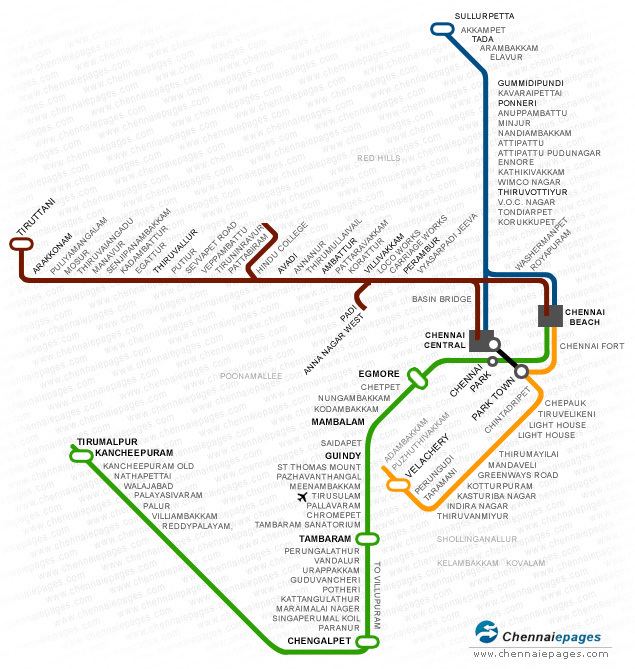 | ||
System length 896.57 km (non-redundant)(303 km true suburban and 610.5 km MEMU service) | ||
Chennai suburban railway new emu
The Chennai Suburban Railway is a commuter rail system in the city of Chennai (Madras), Tamil Nadu, India operated by the Southern Railway, one of the operating railway zones of Indian Railways.
Contents
- Chennai suburban railway new emu
- Chennai suburban railway
- History
- Lines
- North Line
- South Line
- West Line
- MRTS line
- West line
- MRTS Line
- RARE UNIQUE TRAINS Total services
- New Lines
- New Lines proposed in CTS
- Circular Rail Line 191 km
- Services and traffic
- Fares and ticketing
- Maintenance
- Accidents and incidents
- Accident rates
- Security
- References
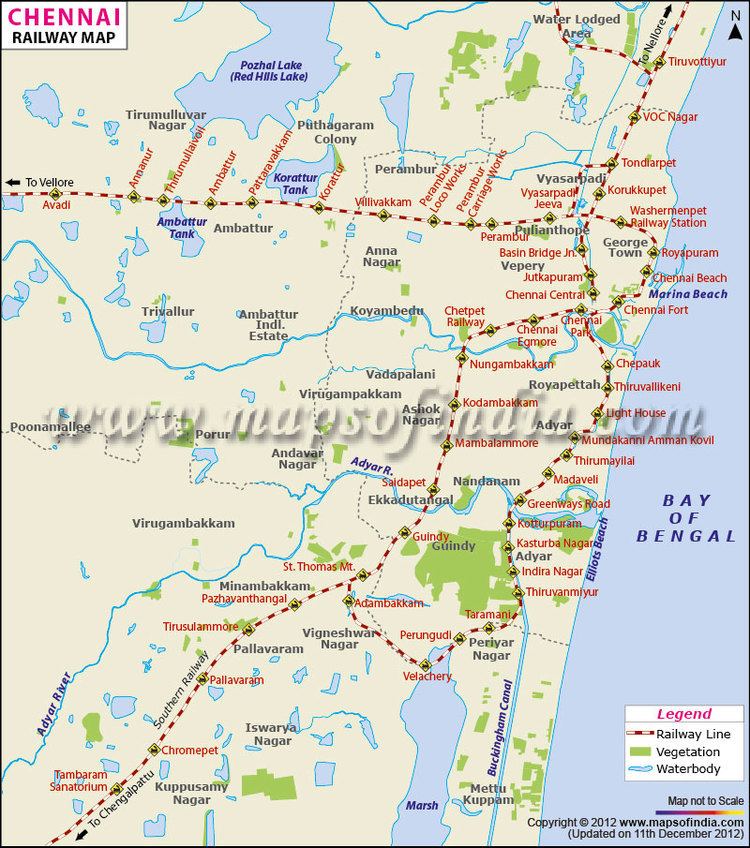
Chennai has a complex railway network. The system uses electrical multiple units (EMUs) operating on alternating current (AC) drawn from over-head cables through the catenary system. The total system spans around 900 km of which only 286 km have dedicated dual tracks for suburban EMUs, the rest share tracks with other trains and are called mainline EMUs (MEMUs). As of 2013, the suburban sector has 580 services, including 250 in the Beach–Tambaram section, 240 services in the Central–Tiruvallur section, and 90 in the Central–Gummidipoondi. As of 2011–2012, 1.46 million people use the suburban train services daily. This includes 500,000 in the Beach–Tambaram section, 350,000 in the Central–Tiruvallur section, and 100,000 in the Central–Gummidipoondi section. This is a 13.2 percent increase over the previous year. A total of 65 stations in the suburban section have cycle stands.

Chennai suburban railway
History

Chennai has a fairly extensive suburban electric multiple unit (EMU) service. It was in the 1920s that the then British government felt the necessity of connecting the northern part of the city, which was mainly commercial, with the chiefly residential southwestern parts. In 1928, work began on constructing two meter gauge (MG) lines connecting the harbour with the southern suburb of Tambaram to run services using steam locomotives. In early 1930, however, the government decided to electrify the lines, including the mainline starting from Egmore. The plan to electrify railway lines in Madras was first initiated in 1923 by Sir Percy Rothera, an agent of the South Indian Railways. This was on account of the city's rapid expansion, with largely agricultural areas such as Saidapet, St. Thomas Mount and Tambaram developing into residential quarters. Plan to build a new line between Beach and Egmore and two lines between Egmore and Tambaram was announced as part of the suburban remodelling initiative of South Indian Railways. The rolling stock, consisting of rigid wooden-bodied coaches, were built by Metro Camell. On 27 December 1930, the first consignment of 25 electric carriages from England was received by the railway. The trains were painted in dull green with a black wheel base and featured wide sliding doors, a better-designed seating arrangement, and thick glass fronts. The new carriages were parked in Tambaram station. By March 1931, the construction works were completed, and the first electrically operated rail service in Madras began on 2 April 1931 between Madras Beach and Tambaram, which became the earliest metre gauge to be electrified in the country. It was launched by Sir George Fredrick Stanley, the then governor of Madras, who at the opening ceremony was reported to have said that the new train services would transform "desolate south Madras into burgeoning garden cities".

However, the suburban services were opened to the public only a month later on 11 May 1931. The section was electrified on 15 November 1931, with the first MG EMU services running on 1.5 kV DC. The Madras Electricity Supply Corporation, which powered the railway lines, was aided by sub-stations in Egmore and Meenambakkam. Soon, the number of trains shuttling passengers was increased to 45 a day, running every 10 minutes at peak hours, and every 30 minutes, otherwise. The running time between Madras Beach and Tambaram stations, which was 2 hours until then, was reduced to 49 minutes. The train service was made available from 4:00 in the morning up to 12:00 at night.
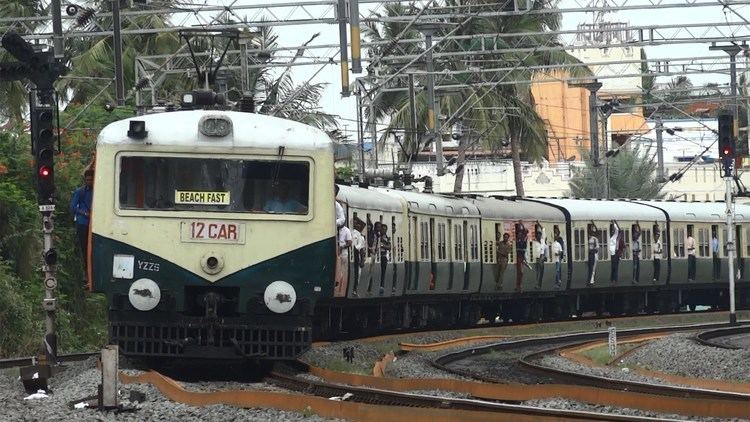
In the same year, mainline DC locomotives (YCG) were introduced to haul freight from the port. The system had the meter-gauge (MG) EMUs (YAU series) until the gauge conversion. Since then, the system has only the broad-gauge (BG) EMUs running.
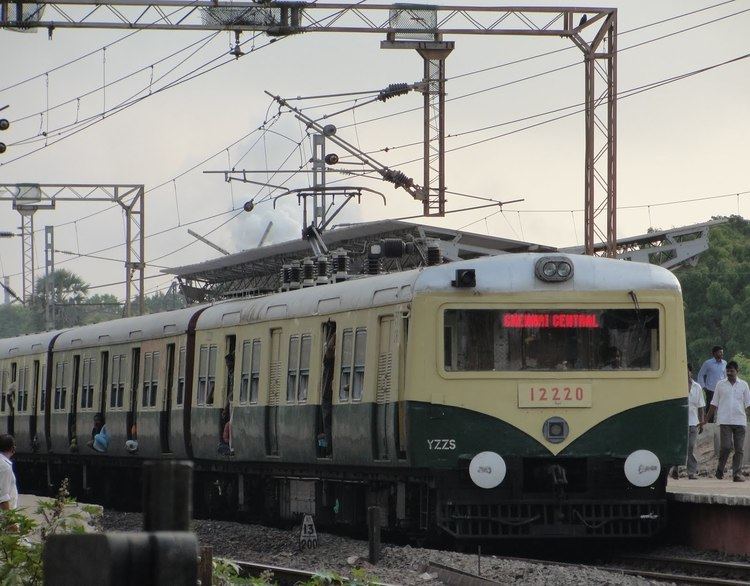
In the 1960s, the line from Madras Beach to Villupuram was converted to 25 kV AC traction. This began with the conversion of the Madras Beach—Tambaram section on 15 January 1967. The rolling stock was changed to EMUs with motors and electricals from Toshiba or Hitachi. These were built by the Integral Coach Factory based in the city. Services too were extended to Chengleput with two daily services. In the late 1967, a Toshiba/Hitachi/Mitsubishi combine model YAM-1 21904 locomotive was introduced, which became the first MG 25 kV AC locomotive. Work on additional MG track between Tambaram and Chengleput began in 1969 and was completed in January 1971.
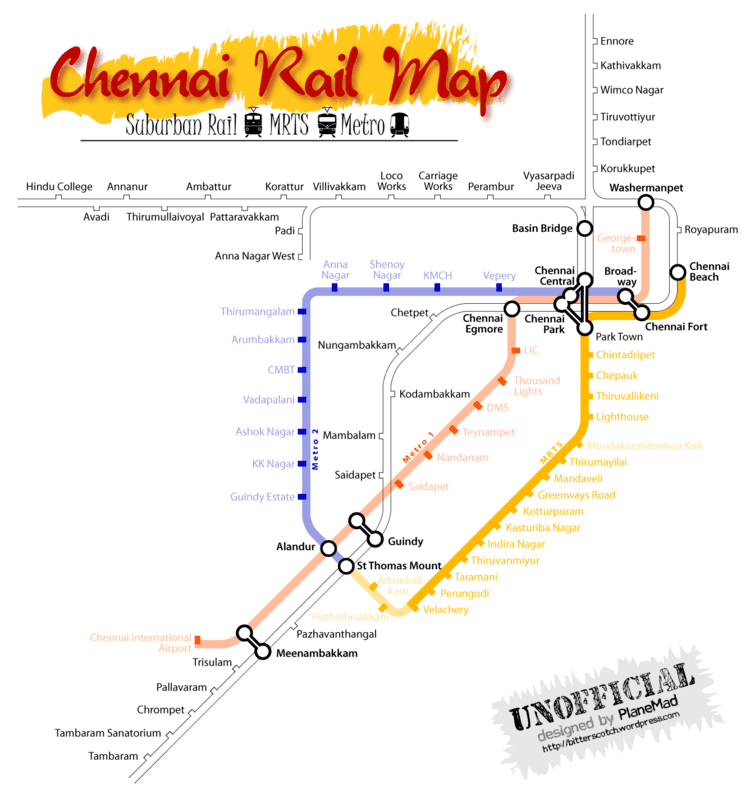
In 1985, suburban services to northern and western parts of the city began from the newly built Moore market terminal exclusively built for sub-urban services earlier they were operating from the central station terminal. With the growth in suburban traffic and the existing gauge lacking sufficient carrying capacity, the Indian Railway decided to convert the entire section between Beach and Tambaram, which by then had three MG lines, to BG in early 1991, with a 50:50 joint venture with the state government. The first BG line was laid in the section in 1992 parallel to the existing MG lines. The work was completed in February 1993. Of the three existing MG lines, two were exclusively used for suburban service and the third one was used for mainline express and passenger trains. The newly laid BG line started handling suburban trains supplementing the MG suburban lines.
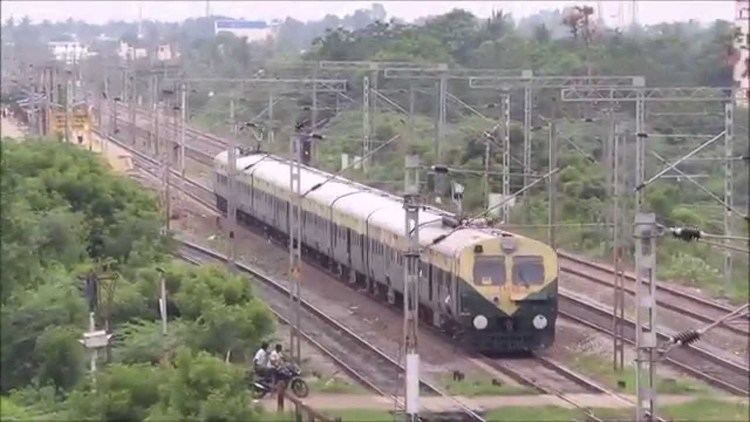
In 1998, further to the Chengleput–Villupuram–Tiruchirapalli gauge conversion project, the railway decided to convert one of the MG lines in the section between Tambaram and Chengleput. However, the decision was soon changed due to large-scale protests by suburban commuters. This resulted in the conversion of the 'down' MG line (the easternmost line out of Tambaram) to BG, in addition to laying of a new parallel MG line. Within a year, work on the new BG was completed. By late 1999, there were two MG lines and one BG line between Tambaram and Chengleput, and the new BG line was electrified by late 2000. The conversion of the mainline MG line between Egmore and Tambaram began in 2000, resulting in Tambaram station temporarily acting as terminal point for mainline express and passenger trains originally originating from and terminating at Egmore. This resulted in increase in traffic at Tambaram station, where two additional MG lines were built. In March 2001, the gauge conversion project in the Madras—Madurai section was completed and BG passenger services began, and the Beach—Tambaram section featured two MG and two BG lines. In December 2001, electrification work of the Chengleput–Villupuram BG line commenced. Gauge conversion work of two MG lines between Beach and Egmore began in December 2002 and was completed by February 2003. This resulted in increased BG EMU services between Beach and Tambaram and the MG services from Tambaram terminating at Egmore. The spur MG lines in the Beach—Washermanpet section were dismantled.
In February 2003, one of the MG lines between Tambaram and Chengalpet was taken up for conversion and was completed in December 2003, which was used for BG EMU services and by mainline express trains. This resulted in 2 BG lines and 1 MG line in the Tambaram–Chengleput section by the end of 2003. The last MG EMU services between the 30 km Egmore—Tambaram section were run on 1 July 2004, marking the end of the regular service of the YAM-1 locomotives, and the gauge conversion work in this section began. All MG mainline trains were switched over to diesel traction.
On 1 November 2004, with the completion of the gauge-conversion work in this section, BG EMU services were inaugurated with the addition of 15 new rakes from ICF.
Lines
Fundamentally Chennai has 4 suburban railway lines, namely North line, West line, South line and MRTS line. The South West line, West North line and West South line are merely minor extensions or modifications of the aforementioned suburban lines. The MRTS is a suburban railway line that chiefly runs on an elevated track exclusively used for running local EMUs or suburban local trains. No express trains or passenger trains run on MRTS line.
North Line
This line runs from the city towards the North direction and hence the name.
Chennai city region Stations: Chennai Central MMC – Basin Bridge – Korukkupet – Tondiarpet – Tondiarpet Yard – Tiruvottiyur – Wimco Nagar – Kathivakkam – Ennore – Athipattu Pudhunagar – Athipattu – Nandiambakkam.
Outside City regions stations
Minjur – Anupambattu – Ponneri – Kavaraipettai – Gummidipoondi – Elavur – Arambakkam – Tada (Andhra Pradesh) - Akkamapet – Sullurpeta
Few train services originate from Chennai Beach instead of Chennai Central. Trains originating from Chennai Beach pass through Royapuram, Washermanpet to reach Korukkupet. From Korukkupet the route is same as listed above.
South Line
(Along GST Road from St. Thomas Mount to Chengalpattu)
Chennai city Region Stations: Chennai Beach – Chennai Fort – Chennai Park – Chennai Egmore – Chetpet – Nungambakkam – Kodambakkam – Mambalam – Saidapet – Guindy – St. Thomas Mount – Pazhavanthangal – Meenambakkam – Tirisulam – Pallavaram – Chromepet – Tambaram Sanatorium – Tambaram – Perungalathur – Vandalur.
Stations Outside Chennai City Regions below:
Urapakkam – Guduvancheri – Potheri – Kattangulathur – Maraimalai Nagar – Singaperumal Koil – Paranur – Chengalpattu – Reddipalayam - Villiambakkam – Palur – Palayaseevaram – Walajabad – Nathapettai – Kanchipuram – Tirumalpur
West Line
Chennai Central MMC – Basin Bridge – Vyasarpadi Jeeva – Perambur – Perambur Carriage Works – Perambur Loco Works – Villivakkam – Korattur – Pattaravakkam – Ambattur – Thirumullaivoyal – Annanur – Avadi – Hindu College – Pattabiram – Nemilichery – Thirunindravur – Veppampattu – Sevvapet Road – Putlur – Tiruvallur – Egattur – Kadambattur – Senjipanambakkam - Manavur-Thiruvalangadu – Mosur – Puliyamangalam – Arakkonam Junction - Tiruttani
MRTS line
The MRTS line is an exclusive line of the Chennai suburban railway as it runs elevated for most of its section. Moreover, the route is unique as it is exclusively used to run suburban EMU trains. No express trains, MEMU trains or passenger trains ply on the MRTS route.
The MRTS currently runs from Chennai Beach to Velachery. However the MRTS line is being extended from Velachery to St Thomas Mount, where it will intersect with the South line and Metro line (Koyambedu – St Thomas Mount). St Thomas Mount station will house South line suburban trains at grade level, MRTS trains at level 1 and Metro trains at level 2.
Between Chennai Beach till Park Town, the MRTS alignment runs parallel to the South Suburban line. Beyond this, the MRTS climbs up on a gradient to reach the Chindadripet station which is elevated. The alignment remains elevated till Perungudi beyond which it slopes down to reach the Velachery station which is at grade level. However, the under construction line between Velachery to St Thomas Mount will be elevated again.
Chennai Beach – Chennai Fort Park Town – Chindadripet – Chepauk – Triplicane – Light House – Mundakanniamman Koil – Mandaveli – Greenways Road – Kottupuram – Kasturbai Nagar – Indira Nagar – Tiruvanmiyur – Taramani – Perungudi – Velachery – Puzhuthivakkam (u/c) – Adambakkam (u/c) – St. Thomas Mount
West line
Chennai Central via Vysarpadi Junction DOWN (destined to any of Pattabiram, Avadi, Trivallur, Arakkonam, Tirutani):89 services of which there are only 3 fast suburban locals on this route.
South Line
North Line
MRTS Line
RARE, UNIQUE TRAINS Total services
New Lines
The following new lines have been proposed in the Second Master Plan by CMDA as a long-term Urban transportation Scheme
The Avadi–Sriperumbudur line will cover a distance of 26.65 km at a cost of ₹ 2,550 million. The railways also plan to lay a 179 km Perungudi–Cuddalore railway line via Mahabalipuram.
New Lines proposed in CTS
The following new lines have been proposed in the Comprehensive Transportation Study of the Chennai Metropolitan Development Authority. These lines will provide a circumferential travel network for the city.
Circular Rail Line [191 km]
Stations: Chennai Beach – Egmore – Tambaram – Chengalpattu – Thirumalpur – Takkolam – Arakkonam – Vyasarpadi Jeeva – Washermanpet – Royapuram – Chennai Beach
Services and traffic
As of 2006, 24 rakes, each with 9 cars, are operated every day between Tambaram and Chennai Beach, with a plan to increase the fleet to 30 rakes.
By 2006, the suburban system carried about 500,000 commuters daily, which rose to about 700,000 by 2009. By 2011, this has increased to 960,000 passengers a day.
By the end of 2013, all the 9-unit EMU services in Chennai Beach–Tambaram–Chengalpattu section were expected to be converted into 12-unit services. With this the carrying capacity of the suburban services would be enhanced by another 25 percent.
Fares and ticketing
Per the 2013 Railway Budget, the railway increased the Chennai suburban ticket fare by eight paise per kilometre, although the railway ministry has hiked it by two paise per kilometre. The number of slabs has also been reduced to four—₹5 (7.4¢ US),₹10 (15¢ US) , ₹15 (22¢ US) and ₹20 (30¢ US)—from the eight slabs earlier. Also ticket denominations have been rounded off to multiples of ₹5 (7.4¢ US). As per the revised slab, a person traveling up to 20 km will have to pay ₹5 (7.4¢ US), between 21 and 45 km ₹10 (15¢ US), between 46 and 70 km ₹15 (22¢ US) and between 71 and 100 km ₹20 (30¢ US).
In 2012 (January–December), the Chennai division of Southern Railway zone generated ₹142.9 million (US$2.1 million) through penalties imposed on ticketless and irregular travellers, which is marginally higher than ₹136 million (US$2.0 million) generated during the previous fiscal (April 2011 – March 2012).
Maintenance
The suburban network has EMU car sheds at Avadi, Tambaram and Velachery where maintenance of EMUs is done. Electrical loco sheds of the Southern Railway are located at Royapuram and Arakkonam where maintenance of electrical locomotives is done. It also has workshops at Perambur Carriage Works and Perambur Loco Works from where periodical overhauling of coaching stock is done. Periodical overhauling of electrical rolling stock is done at Perambur Loco Works and the EMU car sheds at Avadi and Tambaram.
Accidents and incidents
On 29 April 2009, a suburban EMU train from Chennai Central suburban terminal was hijacked by an unidentified man, who rammed it with a stationary goods train at Vyasarpadi Jeeva railway station, killing four passengers and injuring 11 others. A major portion of the platform at the station, a footbridge and the railway track were damaged by the collision. The train was scheduled to start at 5:15 am but started at 4:50 am by the perpetrator. The speed of the EMU train at the time of the collision was estimated to be 92 kmph. There were about 35 passengers on board the train at the time of the accident.
Accident rates
Of the entire stretch of the South line, the Guindy–Chengalpet suburban section, comprising 17 stations, suffers from more fatal accidents with about 30 people a month, peaking at the Chromepet–Tambaram stretch with at least 15 accidents a month as of 2011. Of the 181 people killed on the tracks between Guindy and Chengalpet in 2011, one-fourth were killed on the tracks between Chromepet and Tambaram stations.
Security
In 2013, seven important stations, including Chennai Central, Chennai Egmore, Chennai Beach, Tambaram, Mambalam, Tiruvallur and Basin Bridge, in the suburban section were brought under the Integrated Security System (ISS) of the Southern Railway.
